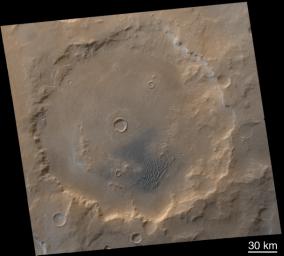Winter Frosted Dunes in Kaiser Crater
Caption:
As the Mars Global Surveyor Primary Mission draws to an end, the southern hemisphere of Mars is in the depths of winter. At high latitudes, it is dark most, if not all, of the day. Even at middle latitudes, the sun shines only thinly through a veil of water and carbon dioxide ice clouds, and the ground is so cold that carbon dioxide frosts have formed. Kaiser Crater (47°S, 340°W) is one such place. At a latitude comparable to Seattle, Washington, Duluth, Minnesota, or Helena, Montana, Kaiser Crater is studied primarily because of the sand dune field found within the confines of its walls (lower center of the Mars Orbiter Camera image, above). The normally dark-gray or blue-black sand can be seen in this image to be shaded with light-toned frost. Other parts of the crater are also frosted. Kaiser Crater and its dunes were the subject of an earlier presentation of results. Close-up pictures of these and other dunes in the region show details of their snow-cover, including small avalanches. The two Mars Global Surveyor Mars Orbiter Camera images that comprise this color view (M23-01751 and M23-01752) were acquired on January 26, 2001.
Cataloging Keywords:
| Name |
Value |
Additional Values |
| Target |
Mars |
|
| System |
|
|
| Target Type |
Planet |
|
| Mission |
Mars Global Surveyor (MGS) |
|
| Instrument Host |
Mars Global Surveyor |
|
| Host Type |
Orbiter |
|
| Instrument |
Mars Orbiter Camera (MOC) |
|
| Detector |
|
|
| Extra Keywords |
Color, Crater, Dune, Water |
| Acquisition Date |
|
| Release Date |
2001-02-08 |
| Date in Caption |
2001-01-26 |
|
| Image Credit |
NASA/JPL/MSSS |
| Source |
photojournal.jpl.nasa.gov/catalog/PIA03206 |
| Identifier |
PIA03206 |

